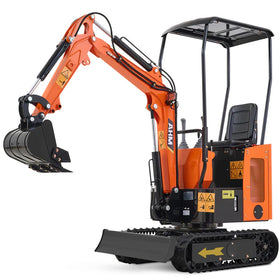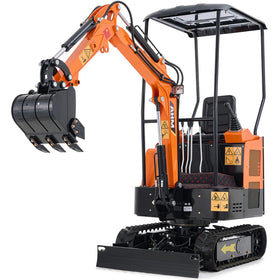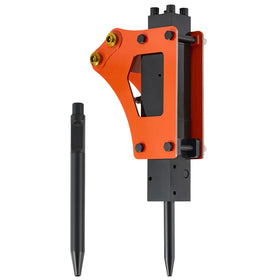Skid steer grading work can make or break your project timeline. The difference between amateur dirt-pushing and professional grading with a skid steer comes down to technique, not just machine power.
Whether you're leveling a yard for sod installation or preparing a construction pad, skid steer grading offers precision and efficiency that is unmatched by larger equipment. Small to medium-frame machines can handle 80% of all grading applications while fitting through standard gates and accessing tight spaces where motor graders can't operate.

Can You Grade with a Skid Steer?
The simple answer is - absolutely! Skid steers excel at grading work because they combine maneuverability with precise control. Unlike bulldozers or motor graders, they can work in residential backyards, around buildings, and in spaces as narrow as 36 inches.
Key advantages of grading with a skid steer:
- Fits through standard 36-inch gates
- Works in spaces inaccessible to larger equipment
- Quick attachment changes for different grading tasks
- Lower hourly operating costs ($50-150/hour vs. $200+ for larger equipment)
- Precise control for finish grading work
Where skid steers work best for grading:
- Residential yard leveling and drainage work
- Preparing small construction pads
- Landscaping projects requiring precise slopes
- Driveway and walkway base preparation
- Foundation backfill and finish grading
Some limitations to consider:
- Large-scale projects (over 5 acres) are better suited for motor graders
- Deep cuts require you to move a significant amount of materials
- Projects needing laser-guided precision over long distances
- Extremely hard or rocky soil

Skid Steer Grading Attachments: What Do You Need?
Picking the right skid steer attachments for grading work affects your results more than the machine size. While standard buckets work for basic grading, specialized attachments deliver professional results.
1. Standard Buckets for Basic Grading
The most important skid steer attachment you need for skid steer grading is a bucket attachment. Low-profile buckets with grading bends work best:
- The bucket should be 2+ inches wider than the tire/track width
- Single bend at the back of the shell for better reverse grading
- Smooth cutting edge for a clean finish work
- 72-inch width is typical for most applications
Specialized Grading Blades
Dedicated grading blades offer superior control:
- 6-way blade adjustment (angle, tilt, offset)
- Spring-loaded cutting edges for consistent contact
- Hydraulic angle control from the operator seat
- 8-foot standard width for most applications
Landscape Rakes
Power rakes prepare surfaces for finish grading, and depending on the nature of the surface you intend to grade, you may need a root grappler for cleaning up debris and bushes, handling logs, and sorting materials
- Remove rocks, roots, and debris
- Create a smooth seedbed preparation
- Adjustable tine spacing for different materials
- Work depths from the surface to 6 inches

How to Grade with a Skid Steer
To prevent reworks and deliver consistent results, follow this systematic approach.
Step 1: Site Preparation and Planning
Survey and mark the area:
- Call 811 before digging to locate utilities
- Mark sprinkler systems and underground lines
- Set grade stakes with string lines for reference
- Establish benchmark elevations using a laser level
Plan your drainage:
- Minimum 2% slope away from buildings
- 6 inches drop within the first 10 feet from structures
- Direct water toward natural drainage or storm systems
- Mark high and low points with flags
Step 2: Rough Grading
Remove obstacles first:
- Use a skeleton bucket for rocks (baseball size and larger)
- Clear debris, roots, and vegetation
- Address the obvious high and low spots
- Create a basic contour and drainage pattern
Material movement:
- Cut high areas and fill low spots
- Work in overlapping passes for consistency
- Maintain consistent blade depth
- Build up areas near buildings first
Step 3: Fine Grading with Back-Dragging
Master the back-drag technique:
- Lower bucket close to the ground, parallel to the surface
- Drive in reverse using the bucket back as a grading blade
- Keep loader arms low, use slight bucket angle adjustments
- Maintain steady speed (avoid wheel spinning in soft soil)
Step 4: Final Adjustments and Testing
Check your work:
- Walk the area looking for inconsistencies
- Test drainage with a garden hose
- Look for standing water or reverse slopes
- Make corrections with light back-dragging passes
Quality control:
- Verify slopes match grade stakes
- Ensure smooth transitions between areas
- Check that water flows away from structures
- Document any areas needing future attention

What Size Skid Steer Do You Need for Grading?
Skid steer grading requirements depend on project scope and material types. Pick one of these three size categories that suits your applications.
Small-Frame Skid Steers (Under 1,750 lb ROC)
Best for precision grading work:
- Residential yard leveling and finish work
- Tight spaces and detailed landscaping
- Operating weight: 3,000-6,000 pounds
- Width: 35-60 inches (fits through standard gates)
- Horsepower: Under 50 HP
Grading applications:
- Final grade preparation for sod installation
- Small drainage corrections
- Walkway and patio base preparation
- Garden bed leveling
Medium-Frame Skid Steers (1,750-2,200 lb ROC)
Sweet spot for most grading projects:
- Commercial and residential applications
- Operating weight: 6,000-7,000 pounds
- Width: 60-72 inches
- Horsepower: 50-70 HP
Grading applications:
- Construction pad preparation
- Driveway base grading
- Parking area leveling
- Medium-scale site preparation
Large-Frame Skid Steers (Over 2,200 lb ROC)
Heavy-duty grading applications:
- Large-scale earthmoving projects
- Operating weight: 7,000-12,000+ pounds
- Width: 72-84 inches
- Horsepower: Over 70 HP
Grading applications:
- Major site preparation
- Road base construction
- Large commercial projects
- Challenging soil conditions

Best Skid Steer for Grading From AHM Corp
AHM SS-38 Mini Skid Steer - $7,199.99
The AHM SS-38 delivers professional skid steer grading capability with the power and precision needed for demanding applications. At 1,733 pounds operating weight with 827 pounds lift capacity, this machine handles serious grading work while maintaining the 45.3-inch width that fits through residential gates and tight job sites.
- 23 HP Briggs & Stratton engine provides consistent power for grading attachments
- Compact 45.3-inch width to navigate residential properties easily
- 30-degree climbing capability handles challenging terrain
- 7-hour operation per tank keeps fuel costs manageable
AHM 4-in-1 Combo Bucket Attachment - $1,299.99
The AHM 41-inch 4-in-1 combo bucket transforms your skid steer into a complete grading machine. This versatile skid steer grading attachment combines bulldozing, clamping, backfilling, and scraping functions in one tool, eliminating time-consuming attachment swaps during complex grading projects.
- 40.6-inch dozer blade width for efficiently spreading materials
- 5 cu. ft. capacity handles significant volumes of materials
- 110° maximum jaw opening angle for versatile material handling
- Back-dragging capability for smooth finish grading
- Quick-attach system for fast installation
AHM Hydraulic Root Grapple - $1,559.99
Site preparation often requires clearing obstacles before grading can begin. The AHM 38-inch hydraulic root grapple excels at removing rocks, roots, and debris that interfere with smooth grading operations. This grading attachment for skid steer applications handles the dirty work so your grading buckets stay sharp and effective.
Site preparation features:
- 37.8x30.5x23.4 inch frame handles large obstacles
- Hydraulic opening and closing for secure material grip
- Optimized jaw design prevents material slippage
- Compatible with AHM, CREWROKS, TYPHON, and other brands
The Bottom Line
Skid steer grading success depends on matching the right machine size to your typical projects and mastering the back-dragging technique. Most residential and small commercial grading work gets handled perfectly by medium-frame machines like the AHM SS-38, which delivers professional results without the overhead of larger equipment.
When choosing the right skid steer, the key isn't buying the biggest machine - it's understanding drainage principles, using proper techniques, and having the right skid steer grading attachment for each job. Master these fundamentals, and your grading work will look professional while staying on schedule and budget.







